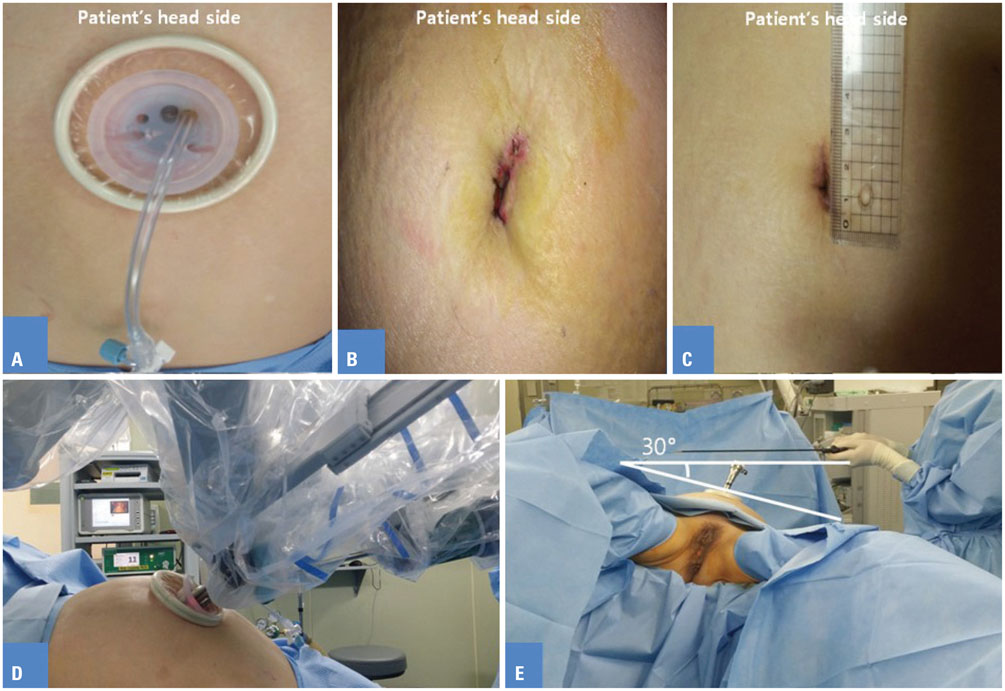Yonsei Med J.
2016 Jul;57(4):1029-1033. 10.3349/ymj.2016.57.4.1029.
Robotic Single-Site® Sacrocolpopexy: First Report and Technique Using the Single-Site® Wristed Needle Driver
- Affiliations
-
- 1Department of Obstetrics and Gynecology, Ewha Womans University School of Medicine, Seoul, Korea. sarahmd@ewha.ac.kr
- KMID: 2374139
- DOI: http://doi.org/10.3349/ymj.2016.57.4.1029
Abstract
- The recently introduced da Vinci Single-Site® platform offers cosmetic benefits when compared with standard Multi-Site® robotic surgery. The innovative endowristed technology has increased the use of the da Vinci Single-Site® platform. The newly introduced Single-Site® Wristed Needle Driver has made it feasible to perform various surgeries that require multiple laparoscopic sutures and knot tying. Laparoscopic sacrocolpopexy is also a type of technically difficult surgery requiring multiple sutures, and there have been no reports of it being performed using the da Vinci Single-Site® platform. Thus, to the best of our knowledge, this is the first report of robotic single-site (RSS) sacrocolpopexy, and I found this procedure to be feasible and safe. All RSS procedures were completed successfully. The mean operative time was 122.17±22.54 minutes, and the mean blood loss was 66.67±45.02 mL. No operative or major postoperative complications occurred. Additional studies should be performed to assess the benefits of RSS sacrocolpopexy. I present the first six cases of da Vinci Single-Site® surgery in urogynecology and provide a detailed description of the technique.
Figure
Cited by 1 articles
-
Outcomes of robotic sacrocolpopexy
Sumin Oh, Jung-Ho Shin
Obstet Gynecol Sci. 2023;66(6):509-517. doi: 10.5468/ogs.23073.
Reference
-
1. Eisenberg D, Vidovszky TJ, Lau J, Guiroy B, Rivas H. Comparison of robotic and laparoendoscopic single-site surgery systems in a suturing and knot tying task. Surg Endosc. 2013; 27:3182–3186.
Article2. Gargiulo AR. Computer-assisted reproductive surgery: why it matters to reproductive endocrinology and infertility subspecialists. Fertil Steril. 2014; 102:911–921.
Article3. Liu H, Lawrie TA, Lu D, Song H, Wang L, Shi G. Robot-assisted surgery in gynaecology. Cochrane Database Syst Rev. 2014; 12:CD011422.
Article4. Lewis EI, Srouji SS, Gargiulo AR. Robotic single-site myomectomy: initial report and technique. Fertil Steril. 2015; 103:1370–1377.
Article5. Maher C, Feiner B, Baessler K, Schmid C. Surgical management of pelvic organ prolapse in women. Cochrane Database Syst Rev. 2013; 4:CD004014.
Article6. Barber MD, Maher C. Apical prolapse. Int Urogynecol J. 2013; 24:1815–1833.
Article7. Tobias-Machado M, Chicoli FA, Costa RM Jr, Carlos AS, Bezerra CA, Longuino LF, et al. LESS sacrocolpopexy: step by step of a simplified knotless technique. Int Braz J Urol. 2012; 38:859–860.
Article8. Nam EJ, Kim SW, Lee M, Yim GW, Paek JH, Lee SH, et al. Robotic single-port transumbilical total hysterectomy: a pilot study. J Gynecol Oncol. 2011; 22:120–126.
Article9. Escobar PF, Knight J, Rao S, Weinberg L. da Vinci® single-site platform: anthropometrical, docking and suturing considerations for hysterectomy in the cadaver model. Int J Med Robot. 2012; 8:191–195.
Article10. Nezhat CH, Nezhat F, Nezhat C. Laparoscopic sacral colpopexy for vaginal vault prolapse. Obstet Gynecol. 1994; 84:885–888.11. Barboglio PG, Toler AJ, Triaca V. Robotic sacrocolpopexy for the management of pelvic organ prolapse: a review of midterm surgical and quality of life outcomes. Female Pelvic Med Reconstr Surg. 2014; 20:38–43.12. Hudson CO, Northington GM, Lyles RH, Karp DR. Outcomes of robotic sacrocolpopexy: a systematic review and meta-analysis. Female Pelvic Med Reconstr Surg. 2014; 20:252–260.13. Yoo HN, Kim TJ, Lee YY, Choi CH, Lee JW, Bae DS, et al. Single-site robotic surgery in gynecologic cancer: a pilot study. J Gynecol Oncol. 2015; 26:62–67.
Article14. Sendag F, Akdemir A, Zeybek B, Ozdemir A, Gunusen I, Oztekin MK, et al. Single-site robotic total hysterectomy: standardization of technique and surgical outcomes. J Minim Invasive Gynecol. 2014; 21:689–694.
Article
- Full Text Links
- Actions
-
Cited
- CITED
-
- Close
- Share
- Similar articles
-
- Outcomes of robotic sacrocolpopexy
- Robotic Total Mesorectal Excision using a Wristed Suctionirrigation Device for Efficient Traction and Visualization
- Single-port plus an additional port robotic complete mesocolic excision and intracorporeal anastomosis using a robotic stapler for right-sided colon cancer
- Robotic Sacrocolpopexy for Treatment of Apical Compartment Prolapse
- Robotic surgery for colorectal cancer




